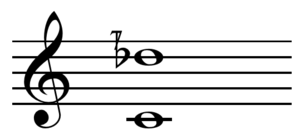Pseudo-octave
Problems playing this file? See media help. | |
Problems playing this file? See media help. | |

A pseudo-octave, pseudooctave,[1] or paradoxical octave[2] in music is an interval whose frequency ratio is not 2:1 (2.3:1[1] or 1.9:1, for example), that of the octave, but is perceived or treated as equivalent to this ratio, and whose pitches are considered equivalent to each other as with octave equivalency. When used as a basis for an equal temperament, the pseudo-octave may also be called the interval of equivalence (IoE), the repeat ratio, and the nonoctave.[citation needed]
Stretched octave[edit | edit source]
The stretched octave, for example 2.01:1, sounds out of tune when played with true harmonic overtones, but in tune when played with tones whose overtones are stretched equivalently.
In piano tuning, stretched octaves are commonly encountered, where the inharmonicity caused by string thickness and tension makes it necessary to widen every interval very slightly. See: stretched tuning.
The octaves of Balinese gamelans are never tuned 2:1, but instead are stretched or compressed in a consistent manner throughout the range of each individual gamelan, due to the physical characteristics of their instruments.[citation needed] Another example is the tritave play on clarinets (help·info) of the Bohlen–Pierce scale (3:1).
Stretched octaves are caused by the physics of standing waves in a stretched wire. The pitch of each overtone produced by a piano string is determined by the ratio of the string's restoring force (expressed as a spring constant), divided by its mass per unit length. In an ideal piano string, the only restoring force would be due to the tension in the string. In practice, piano strings are made from high-carbon steel, which is stiff. Young's modulus of the string steel (tempered high-carbon steel) is what defines the stiffness and does not change with the temper. The stiffness adds an extra restoring force to each string; the amount of this extra force depends on the amount of bend being induced in the string. Higher normal modes bend the string more, inducing more stiffness-related force and sharpening the pitch of the resulting overtone.[citation needed]
Octave stretching is less apparent on large pianos which have longer strings and hence less curvature for a given displacement; that is one reason why orchestras go to the expense of using very long concert grand pianos rather than shorter, less expensive baby grand, upright, or spinet pianos. Another reason is that long strings under high tension can store more acoustic energy than can short strings, giving larger instruments more volume and better sustain than similar, smaller instruments.
See also[edit | edit source]
Sources[edit | edit source]
- ↑ 1.0 1.1 "Interview with Max Mathews", p.21. Author(s): C. Roads and Max Mathews. Source: Computer Music Journal, Vol. 4, No. 4, (Winter, 1980), pp. 15-22. Published by: The MIT Press.
- ↑ "The Paradoxes of Octave Identities", p.213. Author(s): Jenő Keuler. Source: Studia Musicologica Academiae Scientiarum Hungaricae, T. 40, Fasc. 1/3, (1999), pp. 211-224. Published by: Akadémiai Kiadó.
External links[edit | edit source]
| This article uses material from Pseudo-octave on Wikipedia (view authors). License under CC BY-SA 3.0. |
